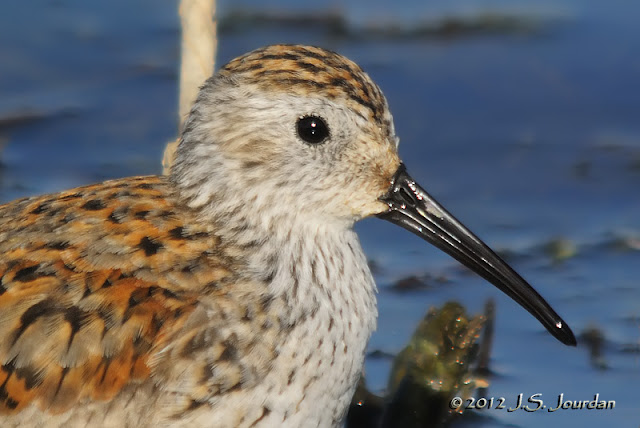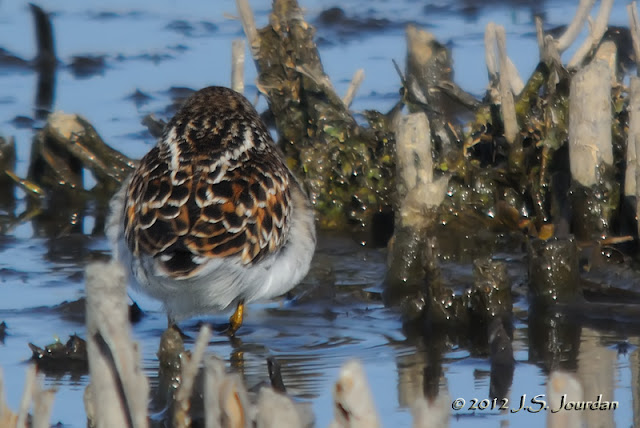Good to be Back! - 11 May 2012
The Walpatich Unit is still low, with lots of exposed mudflats. Lesser Yellowlegs, Least Sandpipers, Semipalmated Plovers, Spotted Sandpipers, and a single Semipalmated Sandpiper were found this late Friday afternoon. Digiscoping was difficult with a still-high sun on the mudflats.
With nothing to note in the Lautenschlager Unit I rode on to the Vermet Unit, where I found six Short-billed Dowitchers foraging among a dozen Dunlin. I captured a few keeper photos of the birds, but found it difficult to get all the birds in focus and capture a frame fast enough to prevent head-blur.
I caught a note or two of a Yellow-headed Blackbird in the Humphries Unit.
I rode out to Cell 3 and found a flock of two-dozen Common Terns roosting on the mudflats next to open water. A single Great Black-backed Gull was farther back taking a nap, while a non-breeding Bonaparte's Gull was between it and the terns. The Forster's Terns were farther north in Cell 4, or in the Humphries Unit, but not on the mudflats. Curious. There were no shorebirds.
I put the scope on the egret rookery in the Humphries Unit and counted almost 200 Double-crested Cormorants covering every single branch. A pair of Cattle Egrets were building a nest, while several Great Egrets were already incubating on their nests. Scattered Black-crowned Night Herons added to the crowd.
Pte. Mouillee SGA (permit required Sep 1-Dec 15), Monroe, Michigan, US
May 11, 2012 5:00 PM - 7:30 PM
Protocol: Traveling
8.0 mile(s)
17 species
Semipalmated Plover (Charadrius semipalmatus) 2
Short-billed Dowitcher (Limnodromus griseus) 7
Spotted Sandpiper (Actitis macularius) 2
Lesser Yellowlegs (Tringa flavipes) 3
Dunlin (Calidris alpina) 13
Least Sandpiper (Calidris minutilla) 6
Semipalmated Sandpiper (Calidris pusilla) 1
Bonaparte's Gull (Chroicocephalus philadelphia) 1
Great Black-backed Gull (Larus marinus) 1
Black Tern (Chlidonias niger) 2
Forster's Tern (Sterna forsteri) 12
Common Tern (Sterna hirundo) 24
Double-crested Cormorant (Nannopterum auritum) 200 Humphries Unit covering every branch in the heron rookery
Black-crowned Night Heron (Nycticorax nycticorax) 3
Western Cattle Egret (Bubulcus ibis) 2 Pair in heron rooker in Humphries Unit. Yellow legs, short, stocky herons w/ orange heads.
Great Egret (Ardea alba) 3
Yellow-headed Blackbird (Xanthocephalus xanthocephalus) 1
View this checklist online at https://ebird.org/checklist/S1
This report was generated automatically by eBird v3 (https://ebird.org/home)
Epilogue: Walt Pawlowski would call me on Saturday (12th) to report a Greater White-fronted Goose (Greenland race) along Haagermann Rd. Dan Elliot would report three Whimbrel and several White Pelicans in Cells 3 and 4.
May 11, 2012 5:00 PM - 7:30 PM
Protocol: Traveling
8.0 mile(s)
17 species
Semipalmated Plover (Charadrius semipalmatus) 2
Short-billed Dowitcher (Limnodromus griseus) 7
Spotted Sandpiper (Actitis macularius) 2
Lesser Yellowlegs (Tringa flavipes) 3
Dunlin (Calidris alpina) 13
Least Sandpiper (Calidris minutilla) 6
Semipalmated Sandpiper (Calidris pusilla) 1
Bonaparte's Gull (Chroicocephalus philadelphia) 1
Great Black-backed Gull (Larus marinus) 1
Black Tern (Chlidonias niger) 2
Forster's Tern (Sterna forsteri) 12
Common Tern (Sterna hirundo) 24
Double-crested Cormorant (Nannopterum auritum) 200 Humphries Unit covering every branch in the heron rookery
Black-crowned Night Heron (Nycticorax nycticorax) 3
Western Cattle Egret (Bubulcus ibis) 2 Pair in heron rooker in Humphries Unit. Yellow legs, short, stocky herons w/ orange heads.
Great Egret (Ardea alba) 3
Yellow-headed Blackbird (Xanthocephalus xanthocephalus) 1
View this checklist online at https://ebird.org/checklist/S1
This report was generated automatically by eBird v3 (https://ebird.org/home)
Epilogue: Walt Pawlowski would call me on Saturday (12th) to report a Greater White-fronted Goose (Greenland race) along Haagermann Rd. Dan Elliot would report three Whimbrel and several White Pelicans in Cells 3 and 4.



















Comments
Post a Comment
Please leave a comment. I will try to respond ASAP.